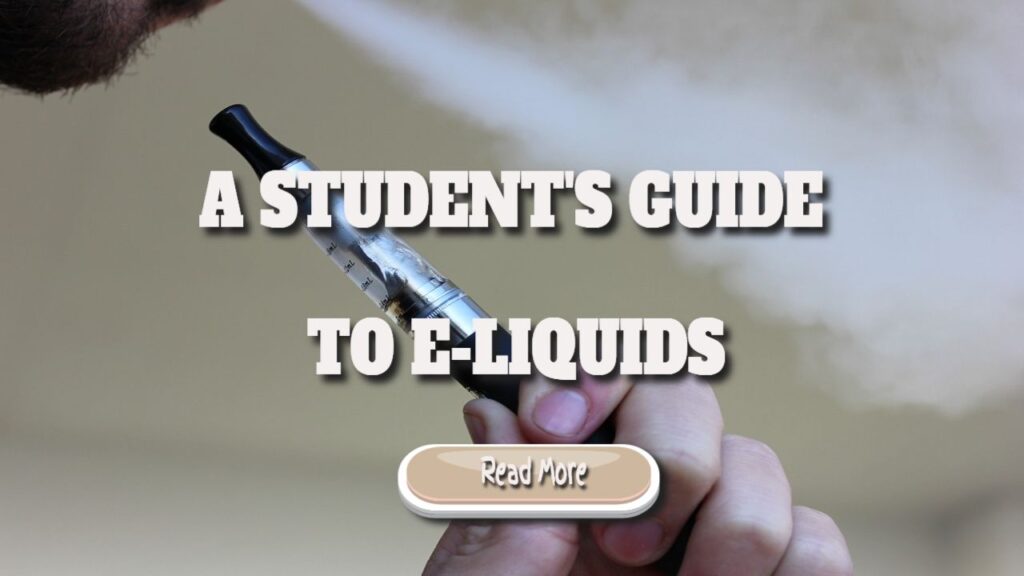A Student's Guide to E-liquids – Vape Industry Has Increased
A Student's Guide to E-liquids- Vape Industry Has Increased: The e-liquid and vape industry has increased in the last decade, and it is nearly unrecognizable from what it previously was. It's no longer simply about tobacco e-liquids and simple vape pens.
It's easy for newcomers and people transitioning from smoking to become overwhelmed by the range of liquids available.
This tutorial will teach you everything you need to know about current e-liquids to keep everything in context.
So, let's get this party started.
What E-liquid Is It?
Simply put, an e-liquid comprises flavour and nicotine (optional). When combined with an electronic cigarette, it distributes nicotine to your body as a traditional cigarette, but without the awful taste, odour, and lethal chemicals.
You've probably heard different names and seen different spellings, but it's all the same in the end.
Thus, you now know that the various names for e-liquid, such as “vape juice,” “vape liquid,” “e-juice,” and “mod juice,” are all synonyms.
One of the reasons for the variety of names is that people have distinct vaping techniques and subcultures.
But you can put that behind you now. It is a liquid in an electronic cigarette device, also known as an e-liquid.
Don't worry, and we'll go over the various varieties below.
E-liquid: How Does It Work?
We know that e-liquid, used in a vape device, contains nicotine and flavourings. But how does it go from a liquid to something we can breathe?
It's pretty simple.
Most vape devices have three parts: a battery, a tank on top, and a coil within the tank.
When you fill the tank with vaporizer juice, it begins to saturate the coil. When you turn on the battery, the liquid heats up and transforms into vapour.
It's the same as boiling a kettle; only you inhale the steam directly into your mouth and lungs.
It's an exact science. The only challenging element is selecting the appropriate liquids (see below) for the appropriate apparatus.
Is E-liquid Safe?
We can't say what long-term consequences vaporizing has on the body because it's still relatively new. There needs to be more time for studies to draw any meaningful findings.
To be clear, we do not recommend beginning vaping if you have never smoked. There is always a risk with anything that enters the body.
However, we can state unequivocally that vaporizing is significantly less dangerous than smoking.
And why is that? Because the NHS, Public Health England, and Cancer Research have all confirmed it for us.
E-liquid, unlike traditional cigarettes, does not contain cancer-causing compounds such as tar and benzene, nor the frightening-sounding carbon monoxide and hydrogen cyanide.
While we can't state that e-liquid isn't dangerous, we can look at the contents to get our opinions.
What Is Contained in E-liquid?
Most approved and licenced e-liquid bottles in the UK include no more than four ingredients:
Food flavouring Nicotine Propylene Glycol – PG Vegetable Glycerin – VG
You might have imagined a slew of bizarre compounds in a single container, but this is far from the case.
If you opened your kitchen cupboard right now, you'd undoubtedly find goods containing everything but nicotine.
Let's look at these chemicals in more detail to determine what we're smoking.
PG stands for PROPYLENE GLYCOL.
This chemical is produced by food safety regulations and is safe for human consumption. It has been utilized in the food sector and drugs we regularly take for decades. This component aids in the transport of nicotine and flavour in e-liquids.
VG stands for VEGETABLE GLYCERIN.
This thick material is also food grade and is used in foods as a sweetener and thickening. This component is obtained from vegetable oils and aids in creating vapour when used in an electronic cigarette.
This is a relatively self-explanatory object. We consume them daily in the United Kingdom. Consider cakes, muffins, yoghurt, ice cream, and beverages.
Nicotine is a highly addictive and dangerous chemical in high doses. However, the actual hazard of nicotine in smoking and vaporizing is addiction. As a result, we do not advocate beginning to vaporize if you have never smoked.
That's all there is to it.
Making e-liquid may appear to be difficult, but it is relatively simple. So simple that hundreds of thousands of individuals worldwide manufacture their juices at home as a pastime or even a sideline.
The possibilities for making various tastes and types of liquids are nearly limitless, and this can sometimes be where vape beginners get stuck.
So, let's look at the varieties of e-liquids and what they represent.
E-liquid Ratios of Different Types
If you've looked into e-liquids before, you'll note that they come in various “ratios.” This refers to the percentage of PG and VG in the drink.
For example, a bottle of vape juice labelled “PG 70/30” includes 70% PG and 30% VG.
Knowing what that means and what is best for you can mean the difference between loving and hating your vape.
Let's examine the ratios more closely.
Juices Based on Pg
People who want to quit smoking frequently use PG-based vape liquids. This liquid has a more potent nicotine concentration and a more powerful throat taste.
These liquids typically have a PG level of over 70% and are intended to imitate the sensation of smoking rather than producing big clouds and performing tricks.
This thinner liquid vaporizes at a lower temperature and can have nicotine levels up to 20 mg.
Juices Based on Vg
VG juices are synonymous with huge, thick clouds and have various unusual tastes.
These thicker liquids have a higher VG content and are vaporized at a higher temperature. As a result, fewer nicotine levels are available. Thus anything more than 6mg is improbable.
Vapour Juices 50/50
50/50 liquids are a hybrid of the finest of both worlds, with 50% PG and 50% VG. As a result, the liquid has a more excellent taste, a better throat hit, and creates more vapour than a PG liquid.
A benefit of 50/50 e-liquids is that they can be used in almost any device and tank.
These liquids' nicotine level ranges from 0 mg to 11 mg, making them suitable for light to medium smokers.
E Liquids with a Short Fill
Short fills are larger nicotine-free e-liquid bottles. You can still add your nicotine as a nicotine shot to the bottle.
Short Fills were created to circumvent TPD restrictions, as nicotine-containing e-liquids cannot be sold in bottles more significant than 10 ml.
As you can see, each of these liquid types has slightly distinct vaporizing preferences, and keep in mind that only some liquids will work with all devices.
So, let's look at the ideal blend ratios for different devices and vapers.
What Is the Best E-liquid Ratio?
We are frequently asked what the best PG-to-VG ratio is, but there isn't one. How a person vape depends on their personal preferences and motivation. Hence there is no ONE BEST ratio.
We can, however, recommend the best blend ratios based on the device being used and the sort of vaper you are.
The Best E-liquid Ratio for Vape Pens
Traditional vape pens are frequently utilized by smokers who are making their first foray into vapour or require a primary device to satisfy their nicotine cravings. These gadgets heat the fluid at a lower temperature since the tanks have a smaller surface area.
An 80% PG juice is a decent starting point for vape pens. If your ratio is less than 50/50, you may need to change your coils more frequently because your juice needs to be thicker.
The Best E-liquid Ratio for Mods
If you observe someone vaping and puffing out massive clouds, they're probably using a sub-ohm mod kit. These devices come in various sizes and designs, but they are all high-powered vaporizers that heat the liquid to a greater temperature.
E-liquids with a more significant VG percentage, including anything above 50% VG, are perfect for these devices. A VG concentration of 80% is good when vaporizing at higher power levels (e.g., 50 watts).
The coil's resistance and the device's output power will affect the liquid's suitability for vaping., so keep that in mind. The higher the resistance of a vaporizer, the less wattage it needs, and vice versa.
Different Coils Require Different E-liquid Ratios
With a standard 1.8 ohm coil, your ideal output should be at most 10 watts.
At this low power, a thinner PG liquid is ideal and can efficiently manage higher nicotine levels.
Heavy VG liquid on these coils will produce incredibly unsatisfactory vapour at this low temperature.
A 0.5-ohm coil, on the other hand, demands more power (30 watts or more) and warms up to a more significant temperature. Therefore a thicker 80% VG liquid would be appropriate.
Using a sub-ohm tank with a PG liquid will cause significant leakage, and the liquid will likely become scorched.
There is a sliding scale between these two extremes where you can modify the ratio of your liquid, but you must follow the following principles:
Power is required for low-resistance coils. Higher temperatures result from increased power. A thicker VG liquid is required at higher temperatures.
Higher resistance coils take less electricity. They are lowering the power, resulting in a lower temperature. A thinner PG liquid is required at lower temperatures.
Following this guidance, you will find the ideal PG/VG liquid ratio for your device and needs after some experimenting.
That is the most crucial aspect of e-liquid ratios, but what about nicotine strength?
How Do I Select the Best Nicotine Strength for an E-liquid?
As we've seen, selecting the proper type of liquid is heavily influenced by your device and your vaping goal.
These considerations come into play when deciding on the appropriate nicotine strength.
To make things easier, examine the type of smoker you are or were:
Eliquid Nicotine Strength for Heavy Smokers
A heavy smoker smokes more than 15 cigarettes daily, which is more than enough for one day!
Even though you believe you should go for the maximum strength attainable, you will need more satisfaction.
So, in the first few weeks of smoking, it's recommended to experiment with 11 mg, 16 mg, 18 mg, and 20 mg to see what satisfies your needs.
These nicotine levels are often only available at 70% PG and above, necessitating a vape pen or non-sub-ohm device.
Light Smoker Nicotine Strength
Light smokers typically consume up to ten cigarettes each day. So, while nicotine cravings must be fulfilled, the demand for high nicotine concentrations is not as critical.
As a result, you have a more comprehensive range of liquids to vape while successfully suppressing your nicotine cravings.
The most common nicotine strength is 3 mg, available for all e-liquid kinds, including PG, VG, and 50/50.
It is recommended, however, to begin with somewhat larger nicotine content, so a strength of 6mg would be an excellent choice to offer you the freedom of what type of liquid you use.
6mg is easily obtained in PG and 50/50 e-liquid. However, VG may be a little more complicated.
E-liquid Nicotine Strength for a Non-smoker
We don't need to discuss this point. But we'll do it regardless.
You don't need nicotine if you don't smoke.
So, if you want to vaporize, always select 0mg. These are available in short-fill bottles and for all liquid types (which are all nicotine free).
The post A Student’s Guide to E-liquids – Vape Industry Has Increased appeared first on https://gqcentral.co.uk


Comments are closed